In this article, I will review both the 700-watt and 300-watt Ecosun infrared heating panels that I have at home.
This article includes:
- box content and installation
- panels specifications
- our first impression of infrared panels
- how do they look
- how their warmth feels
- available accessories
- how long do they last
- energy use and efficiency
- health and safety
- links to more in-depth articles
- conclusion
What is an infrared heating panel?
Infrared heating panels are thin aluminum panels that provide space heating through infrared radiation. Infrared heating panels work on electricity.
You can read all about infrared heating panels in my article:
Why we chose infrared panels over other heating options
At the end of summer 2020, my girlfriend and I moved into an old uninsulated space. We were interested in infrared heating panels because they are very easy to install and use. Because of the potential to use green electricity to power them, we decided to see if they can function as the primary source of heating.
What is included when you buy an infrared heating panel?
Our Ecosun infrared heating panels came in a cardboard box. Inside the box were:
- the panel itself
- a mounting frame, and
- a piece of paper with mounting instructions
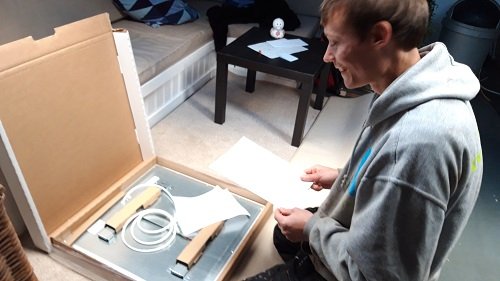
The infrared panels we bought are white, have a rough surface, and include 4 iron straps/shackles to hang the panel onto the mounting frame. (there are different types available, see later in this article)
Infrared panel pictures
The following pictures are of our 300 W infrared panel.
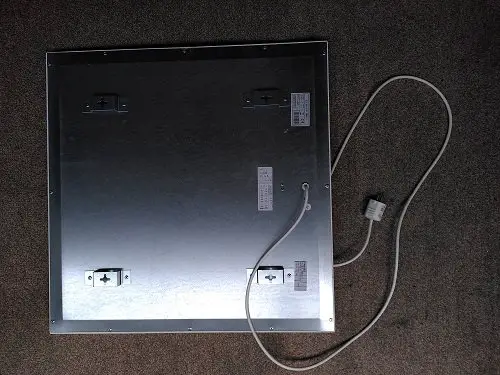
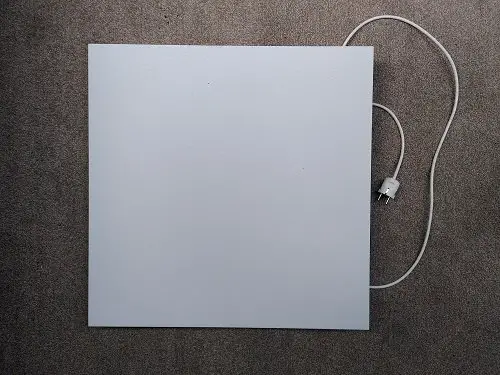

Easy to mount and install
As you can see in the pictures, the backside of the panel has four metal straps. These can easily be slid over the ‘hooks’ sticking out at the top and bottom of the mounting frame. Installation is therefore very easy, and the panels can also be removed from the wall with ease.
Additionally, an electricity cable of approximately 6.5 feet (200 cm) without a power plug is coming from the back of the panel. (the pictures are from after I installed a power plug myself) A power plug was not included because, when you want to connect the panel to the electricity cables in your home, you will need to cut it off. Cutting off the power plug, however, makes you lose the warranty.
However, connecting a power plug is quite easy, and can be done without losing your warranty. I connected a power plug myself without having done it before. Other brands of infrared panels might include a power plug already.
Infrared heating panel specifications
The following table shows the specifications of both the 300 and 700-watt panels that we own.
| Specifications | 300 W panel | 700 W panel |
|---|---|---|
| Size | 23.4 x 23.4 inches (59,5 x 59,5 cm) | 23.4 x 47 inches (59,5 x 119,5 cm) |
| Weight | 12.15 pounds (5,51 kg) | 24,29 pounds (11,02 kg) |
| Distance from wall when mounted | 2 inches (5 cm) | 2 inches (5 cm) |
| Cable length | 6.5 feet (195 cm) | 6.5 feet (195 cm) |
First impressions
The panels do not have an on/off switch
These panels are a very basic design that simply runs when they are plugged in. They do not have an on/off switch or anything to turn the heat up or down.
Not having any buttons, screens or other electronics is honestly a relief. Just unplugging the heater when the room is sufficiently warm is totally fine by me. If you want a little more control over the heat output, you can always purchase an adjustable thermostat. See below for more information on a thermostat and other accessories.
The heating takes some getting used to
Normal heaters heat up the air. This results in:
- air movement due to rising warm air
- dry air, since heating air lowers its humidity
- it takes time to heat all the air, especially in a large room
Infrared panels do not heat the air but instead produce warm rays just like the sun. This feels very different from what we are used to for indoor heating. And I personally love it.
A different kind of warmth
Instead of stuffy warm air that feels dry, infrared warmth feels just like sitting in the sun. However, this means that, when starting up the panels, the warmth is only felt directly in front of the panels. The indoor air remains fresh and relatively cool. This feels similar to being outside on a sunny morning when the air is still relatively cold from the night. I love these sunny cool mornings and can now experience them indoors.
Eventually, the room temperature rises due to the infrared rays heating furniture and walls, which, in turn, start giving off their heat to the surrounding air. This, again, is similar to a sunny day where the sun eventually heats the outdoor air. How long it takes for the room to heat up depends on factors like insulation and starting temperature. Later in this article, I discuss how long it takes to heat a room.
Since infrared panels act similar to sunrays, however, this also means that when you are not directly in front of the panel, you are basically in the shade and won’t feel the warm rays. In my experience, you will want to sit close to the panel in the early morning. Just like you would want to sit close to any other heater when the air is cold.
Useful accessories that are not included with the panels
there are two useful accessories that are not normally included when purchasing an infrared heating panel. These accessories are:
- legs for creating a movable standing panel
- an adjustable thermostat that controls the panel

Normally, infrared panels are mounted to the ceiling or wall. Therefore, a mounting frame is included with the panel. However, if you want to use the panel as a portable heater, you might want to purchase these legs. With these legs, the panel can be placed standing vertically. For example, a small panel can be used to heat your legs underneath your desk.

This type of adjustable thermostat is plugged into the wall socket and the panel’s plug can be plugged in. You can simply set the desired room temperature, and the panel will be shut down when that temperature is reached.
What types of infrared panels are available?
Infrared heating panels are available in several forms. There are:
- flat white panels with a rough surface (such as the ones I own)
- flat white panels with a smooth surface
- infrared panels that are also a mirror
- infrared panels with a picture
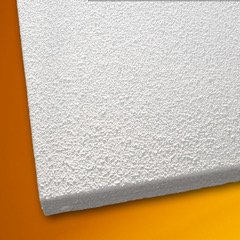

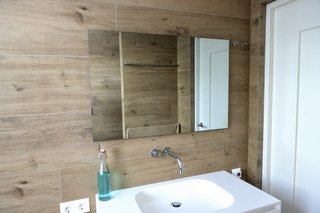
Why we chose a rough-surface panel
We had no desire for a mirror or picture panel since we wanted the panels to not stand out on our white walls. We did, however, choose to go for rough-surfaced panels over smooth panels. We mostly did this because our local seller said that the heat distribution for rough panels is better due to their higher surface area.
I can imagine, however, that it is easier to clean a smooth-surfaced panel. So if the panel will be hanging somewhere where it might get dirty, a smooth panel could be a good choice.
How long does it take to heat a room with infrared panels?
To heat up an average-sized 330 square-foot room from 50 °F (10 °C) to 68 °F (20 °C), a 1500 watts panel takes about 5 minutes. However, factors such as insulation, outdoor temperature, objects in the room, and humidity levels increase the time needed to heat the room.
I wrote an article on this subject and included a handy calculator. You can also find a table with how many watts are required per room size and room type. You can find it here: How long does it take an infrared heater to heat a room?
How long do infrared heating panels last?
Infrared heating panels are very durable and will last for about 100.000 hours. this means you can run them 24/7 for about 11 years! These panels last much longer than other types of infrared heaters, which usually last about 10.000 to 60.000 hours. For a comparison between the different types of infrared heaters, please read my article: How long do infrared heaters last? (quartz, carbon, and panel heaters).
Do infrared heating panels save money on heating?
Unfortunately, using electricity for heating is not the most cost-effective means. Gas-fired heaters remain the cheapest means of heating a house. However, gas is both dangerous and not environmentally friendly. Electric heating powered by renewable energy has the potential to make our heating fully sustainable and is much safer.
If you are already making use of electric heaters, infrared heaters do reduce your energy bill. Infrared heaters are the most effective way of heating. They can save up to 40% on your electricity bill as they are 40% more efficient compared to other electric heaters. You can read all about the efficiency and cost savings of infrared heaters in my article: Do infrared heaters save on your electric bills?
Do infrared heating panels get hot?
Infrared heating panels do not get hotter than 212 degrees Fahrenheit (100 degrees Celsius). They can be touched for about 2 seconds and cannot cause a fire. Additionally, they warm up in less than 5 minutes and cool down within 5 minutes when turned off. You can read all about infrared heaters safety in my article: Infrared heaters safety (fire, radiation, safe practices)
Is infrared heating healthy?
Infrared heating is perfectly healthy. Its warming radiation is similar to sunshine without harmful UV light. In fact, our skin naturally prefers infrared heat over warm air heating. Therefore, as has been found in several studies, infrared rays improve skin tightness and reduce wrinkles.
Additionally, infrared heating panels provide other health benefits such as:
- no emission of gases or other harmful airborne compounds
- no air movement is created
- no fire hazard
- stable humidity
- prevention of condensation
If you want to read more about the benefits of infrared heating, please read my article: The benefits of infrared heating: health and safety.
In my article: Can infrared heaters cause health problems? I discuss common questions about infrared radiation and our health.

The downsides of infrared heating panels
Electricity costs are relatively high
The biggest downside to infrared heating is that they run on electricity, which is relatively expensive compared to gas. Running an infrared heating panel for a month (6 hours per day) will cost about 55 dollars while running a gas-fired heater for a month only costs 23 dollars. (data from 2021)
Currently, in 2022, gas prices are soaring and electric heating becomes more and more attractive. This means now is a great time to switch to infrared-based heating. Maybe next to a heat pump? You can find more information about heat pumps on my website, here.
If you want to read a more in-depth article on the running costs of gas vs electricity as well as a comparison in health and safety, you can read my article: Infrared heating vs gas (running costs, application, health and safety)
However, since the world is moving away from fossil fuels, we are more and more using electricity for our energy needs. This means that infrastructure will be added to support the need for electricity and prices will go down eventually.
Precise placement is required
Panel heaters should be placed in such a way that nothing is blocking their heat output. Normally, a warm-air heater can be tucked away behind the couch or underneath a window. In this way, the warm air can rise and move around the room. Since the warming infrared rays can easily be obstructed by furniture, careful placement is required.
Therefore, mounting the panels on the ceiling is recommended. When mounting the panels to a wall, make sure there is no furniture directly in front of it. In this way, the warmth is most effectively distributed around the room.
I highly recommend checking out my article: infrared heating pros and cons. This article goes into depth on all the advantages and disadvantages of infrared heating.
Conclusion
Infrared panel heaters are a very comfortable form of heating that provides several health and safety benefits over traditional warm-air heating. The biggest downside, for now, is that switching to infrared heaters greatly increases your electricity use.
I think infrared heating is the future of heating. It takes some getting used to, but because of the health and safety benefits over traditional heating, it will eventually replace fuel-based heating systems.
If you want to support me and this website, please use this link to the available infrared heating panels on amazon.com for your purchase.
